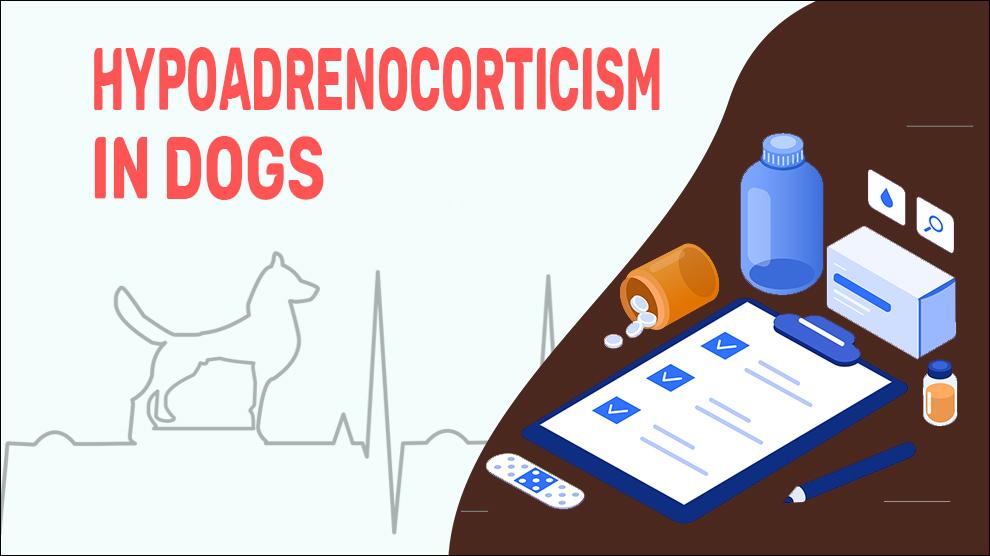Hypoadrenocorticism is an autoimmune disorder resulting in decreased production of adrenocortical hormones such as glucocorticoid (cortisol) and mineralocorticoid (aldosterone) production or both from the outer part or cortex of the adrenal gland.
Also called Addison's disease, this is mostly found in young to middle-aged dogs and in female dogs. The incidence of hypoadrenocorticism is an uncommon illness, with estimates of its ranging < 0.5%. Hypoadrenocorticism clinical signs occur when at least 90% of the adrenocortical tissue is damaged, leading to deficiencies of glucocorticoids and mineralocorticoids.
Primary adrenocortical failure happens from the destruction or atrophy of all 3 adrenal cortical layers, which results in insufficient secretion of adrenocortical hormones. There is no report of Spontaneous recovery.
Canine hypoadrenocorticism is often referred to as the great imitator as it presents with nondescript signs and is rarely pathognomonic. Although it is uncommon in dogs, pet owners should consider the diagnosis with the proper signalment and clinical signs.
Almost 80% of dogs will have hyponatremia and hyperkalemia. 90% of dogs with Hypoadrenocorticism will not have a stress leukogram. Anemia, Azotemia, metabolic acidosis, hypoglycemia, and hypercalcemia can also be seen. Electrolyte derangements are not seen in dogs with atypical Addison’s, as the hyponatremia and hyperkalemia arise secondary to aldosterone insufficiency.
Symptoms Of Hypoadrenocorticism
- Hypoglycemia
- Weakness, hypotension, and microcardia
- Dehydration and hemoconcentration
- Hyperkalemia or a low sodium/potassium ratio
- Hypocholesterolemia
- Eosinophilia
- Emesis
- Anorexia
- Diarrhea/ Increased urination
- Poor appetite / Weight loss
- Dehydration
- Excessive thirst
- Poor perfusion (feet are colder with a normal core body temperature)
- Peripheral vasoconstriction
Treatment Options For Hypoadrenocorticism
- There is no out-and-out cure for Hypoadrenocorticism in dogs; however, there are suitable hormone replacement therapies to successfully manage the condition.
- To replace the deficient hormones, dogs require continuous management through drug therapy:
- Mineralocorticoid replacement: desoxycorticosterone pivalate (DOCP) or synthetic hormone fludrocortisone acetate (Florinef, Florinef Acetate).
- DOCP is the economical option (Percorten-V, Novartis)
- Glucocorticoid replacement: hydrocortisone or Oral prednisone
- Regularly do blood tests to check electrolyte and hormone levels
Home Remedies For Hypoadrenocorticism
- Medication expenses can be high and some owners cannot afford continued expenses so they may choose euthanasia.
- Thorough monitoring by the owner and appropriate medication has a good prognosis.
- Chaotic situations such as new places, family functions, or tragedies may need the usage of more medications (like cortisol).
Prevention Of Hypoadrenocorticism
- There is no way of preventing of Hypoadrenocorticism.
- Provide a home-prepared diet of grass-fed, organic ingredients.
- The prescribed prednisone dosage should be tapered off gradually otherwise dogs might experience withdrawal symptoms.
- Sudden weakness and Addisonian crisis (hypovolemic shock: bradycardia, severe vomiting, and sometimes collapse) can be prevented.
Affected Breeds Of Hypoadrenocorticism
Young to a middle-aged female dog, Great Dane, Nova Scotia Duck Tolling Retriever, West Highland White Terrier, Rottweiler, Labrador Retriever, Bearded Collie
Additional Facts For Hypoadrenocorticism
1. Causes:
The cause of primary adrenocortical failure is mostly an autoimmune response. Other causes include hemorrhage, infarction, destruction of the adrenal gland by granulomatous disease, metastatic tumor, agents (mitotane), or adrenal enzyme inhibitors (trilostane).
2. Types:
Primary Addison’s disease: Autoimmune destruction of adrenal gland functions.
A typical type of Primary Addison's disease:
- Deficiency of mineralocorticoids and Glucocorticoids.
- A consequence of the dog’s autoimmune obliteration of adrenal cortical tissue.
- Idiopathic- the reason for this is unknown.
Atypical type of Primary Addison's disease:
1. In veterinary medicine, this is said to be "the great imitator".
2. The conventional Addisonian dog’s complete adrenal cortex is lost; on the other hand, the atypical case affects only sections of the zones and spares the glomerulosa layer, resulting in varied clinical presentations.
3. Glucocorticoid deficient-only hypoadrenocorticism is the most prevalent atypical form.
Secondary Addison's disease:
- When the issues originating from other regions such as a tumor or in the pituitary gland cause Addison's disease.
- A sudden interruption of long-term exogenous administration of corticosteroids or progesterone analogs can also cause this condition.
3. Morbidity:
More commonly, isolated glucocorticoid insufficiency is seen in older dogs with lethargy, hypoglycemia, weight loss, normal electrolyte concentrations, hypocholesterolemia, and hypoalbuminemia.
Primary hypoadrenocorticism - Young to middle-aged female dogs
Atypical hypoadrenocorticism - Older dogs
4. Mortality:
Hypoadrenocorticism is a disorder with serious sequela. Meanwhile, Hyperadrenocorticism goes ignored until it becomes a medical emergency. Manifestation of symptoms is abrupt and can be extremely severe. This is called adrenocortical insufficiency ("Addisonian crisis"). This acute adrenocortical emergency includes critical symptoms such as shock and bradycardia. For Addisonian symptoms, there is no other choice other than immediate veterinary care.
5. Diagnosis:
- Complete blood count (CBC)
- Biochemical profile
- ACTH- stimulation test
- Baseline cortisol
- Urine cortisol creatinine ratio
- Plasma renin levels
6. Prognosis:
If Left untreated, Hypoadrenocorticism is often life-threatening, but luckily, dogs with Addison's disease can have a relatively normal life expectancy with proper treatment and disease management.
When To See A Vet
Contact your vet right away, if you notice any of the following:
- Hypoglycemia
- Weakness, hypotension, and microcardia
- Dehydration and hemoconcentration
- Hyperkalemia or a low sodium/potassium ratio
Food Suggestions For Hypoadrenocorticism
- Protein- liver, chicken/ turkey breasts, ½ Cup cooked or raw Salmon.
- Lean meats, such as chicken breast, sirloin, or pork.
- Zinc foods such as Oysters, Pork, tuna, etc.
- Blueberries, Broccoli, Beef liver, carrots, etc.
- Omega-3 oily fishes DHA - sardines, mackerel, salmon, herring, caviar, etc.
- Antioxidants- blackberries, Blueberries, Steamed broccoli, spinach, cooked yellow squash, green beans, and kale.
Conclusion
For a condition like hypoadrenocorticism, your dog’s yearly veterinary check-up should not be missed.
Even for the dogs that are well regulated, evaluate them at least twice yearly, with a physical examination and routine bloodwork.

















